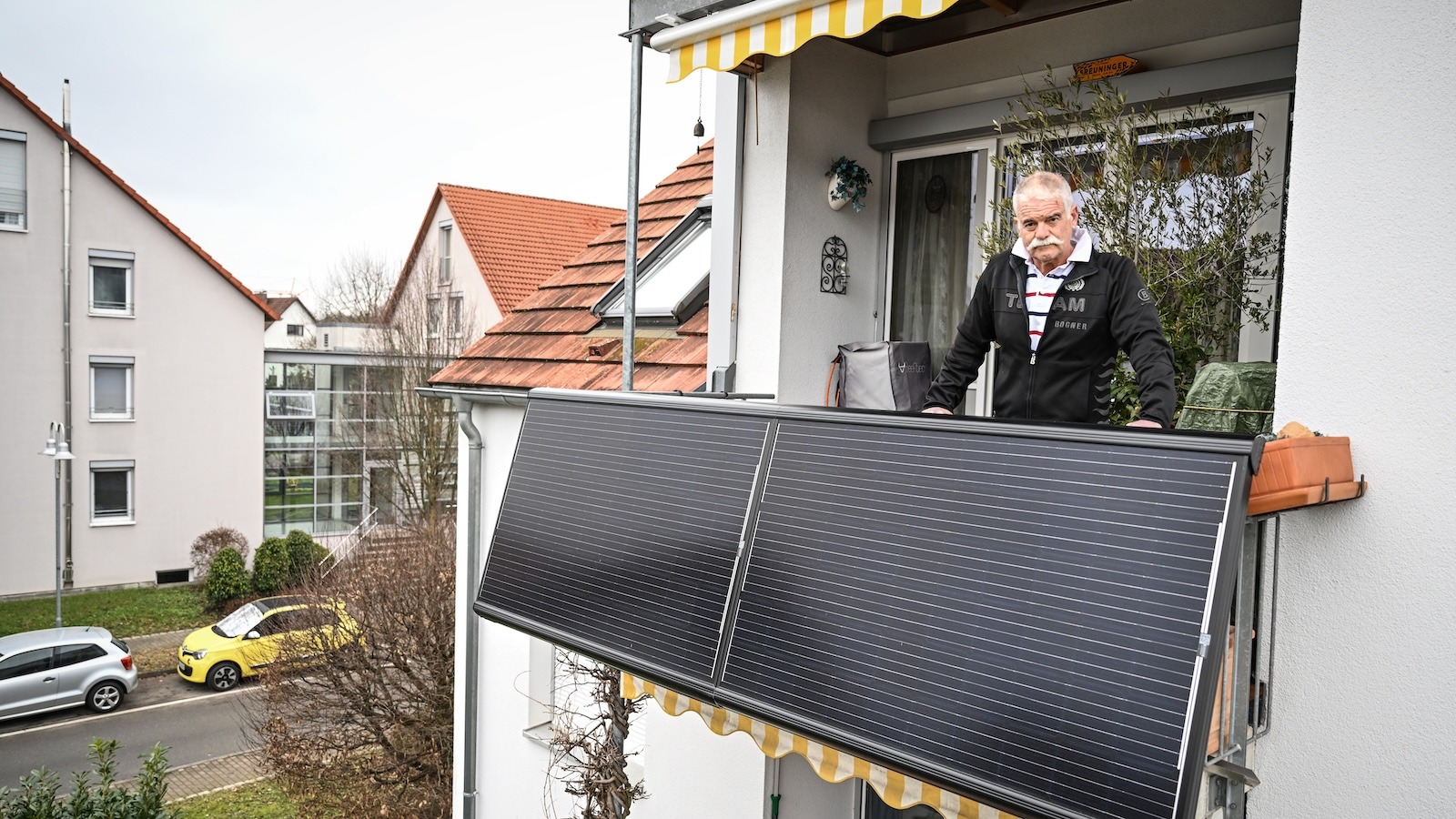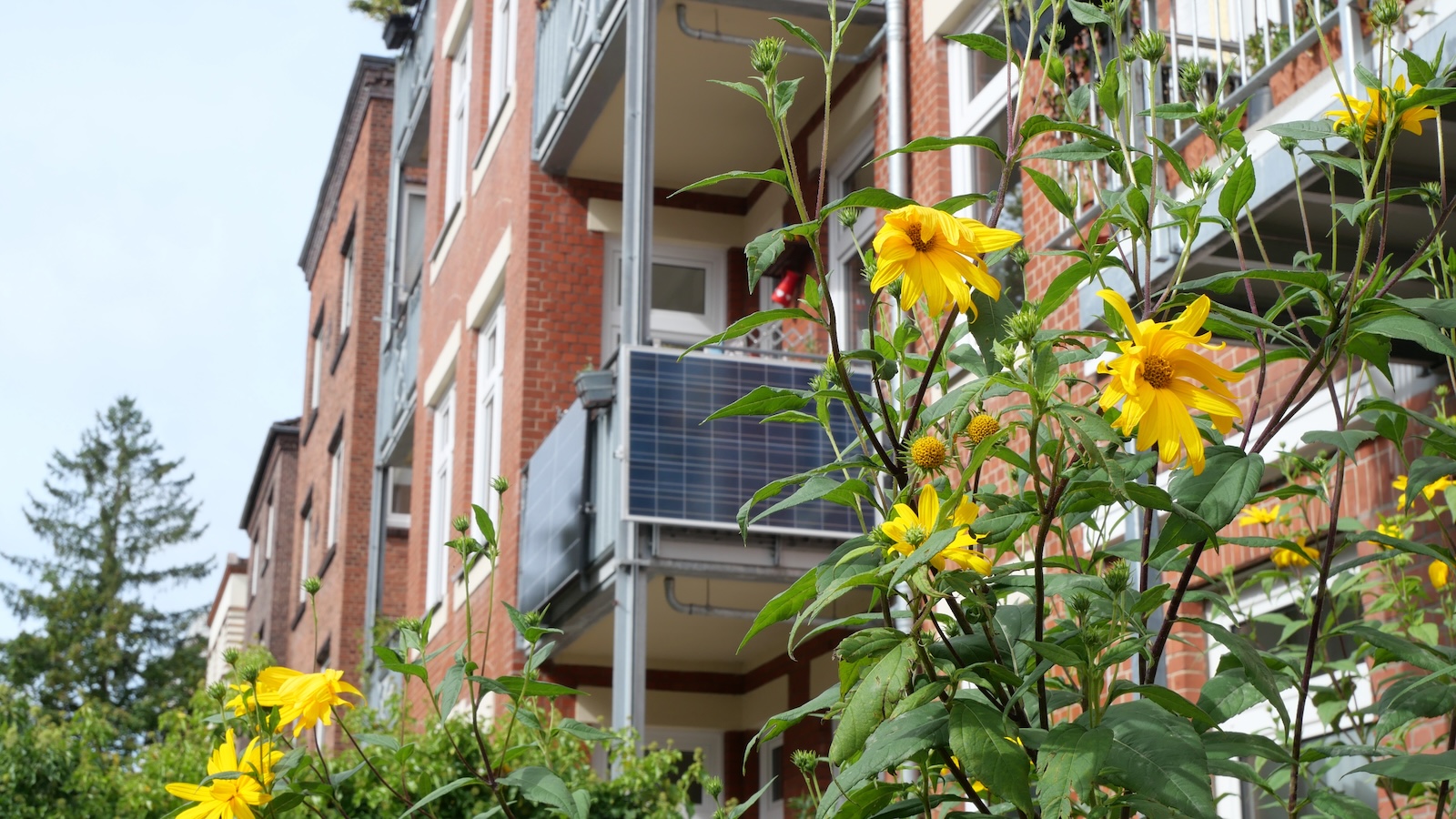Raymond Ward wants to see solar panels draped over every balcony in the United States and doesn’t understand why that isn’t happening.
The technology couldn’t be easier to use — simply hang one or two panels over a railing and plug them into an outlet. The devices provide up to 800 watts, enough to charge a laptop or power a small fridge. They’re popular in Germany, where everyone from renters to climate activists to gadget enthusiasts hail them as a cheap and easy way to generate electricity. Germans had registered more than 780,000 of the devices with the country’s utility regulator as of December. They’ve installed millions more without telling the government.
Here in the U.S., though, there is no market for balcony solar. Ward, a Republican state representative in Utah who learned about the tech last year, wants that to change. The way he sees it, this is an obvious solution to surging power demand. “You look over there and say, ‘Well, that’s working,’” he told Grist. “So what is it that stops us from having it here?”
His colleagues agree. Last month, the Legislature unanimously passed a bill he sponsored to boost the tech, and Republican Governor Spencer Cox signed it. H.B. 340 exempts portable solar devices from state regulations that require owners of rooftop solar arrays and other power-generating systems to sign an interconnection agreement with their local utility. These deals, and other “soft costs” like permits, can nearly double the price of going solar.
Utah’s law marks the nation’s first significant step to remove barriers to balcony solar — but bigger obstacles remain. Regulations and standards governing electrical devices haven’t kept pace with development of the technology, and it lacks essential approvals required for adoption — including compliance with the National Electrical Code and a product safety standard from Underwriters Laboratories. Nothing about the bill Ward wrote changes that: Utahans still can’t install balcony solar because none of the systems have been nationally certified.
These challenges will take time and effort to overcome, but they’re not insurmountable, advocates of the technology said. Even now, a team of entrepreneurs and research scientists, backed by federal funding, are creating these standards. Their work mirrors what happened in Germany nearly a decade ago, when clean energy advocates and companies began lobbying the country’s electrical certification body to amend safety regulations to legalize balcony solar.
In 2017, Verband der Elektrotechnik, or VDE, a German certification body that issues product and safety standards for electrical products, released the first guideline that allowed for balcony solar systems. While such systems existed before VDE took this step, the benchmark it established allowed manufacturers to sell them widely, creating a booming industry.
“Relentless individuals” were key to making that happen, said Christian Ofenheusle, the founder of EmpowerSource, a Berlin-based company that promotes balcony solar. Members of a German solar industry association spent years advocating for the technology and worked with VDE to carve a path toward standardizing balcony solar systems. The initial standard was followed by revised versions in 2018 and 2019 that further outlined technical requirements.
The regulatory structure has continued to evolve. Ofenheusle has worked with other advocates to amend grid safety standards, create simple online registration for plug-in devices, and enshrine renters’ right to balcony solar. Politicians supported such efforts because they see the tech easing the nation’s reliance on Russian natural gas. Cities like Berlin and Munich have provided millions of euros in subsidies to help households buy these systems, and the country is creating a safety standard for batteries that can store the energy for later use.
Tobias Schwarz / AFP via Getty
Meanwhile, the United States has yet to take the first step of creating a safety standard for the technology. U.S. electrical guidelines don’t account for the possibility of plugging a power-generating device into a household outlet. The nation also operates on a different system that precludes simply copying and pasting Germany’s rules. The U.S. grid, for example, operates at 120 volts, while that country’s grid operates at 230 volts.
Without proper standards, a balcony solar system could pose several hazards.
One concern is a phenomenon called breaker masking. Within a home, a single circuit can provide power to several outlets. Each circuit is equipped with a circuit breaker, a safety device within the electrical panel that shuts off power if that circuit is overloaded, which happens when too many appliances try to draw too much electricity at the same time. That prevents overheating or a fire. When a balcony solar device sends power into a circuit while other appliances are drawing power from the circuit, the breaker can’t detect that added power supply. If the circuit becomes overloaded — imagine turning on your TV while a space heater is running and you’re charging your laptop, all in the same room — the circuit breaker might fail to activate.
This was a concern in Germany, so it developed standards that limit balcony solar units to just 800 watts, about half the amount used by a hairdryer. That threshold is considered low enough that even in the country’s oldest homes, the wiring can withstand the heating that occurs in even the worst of worst-case scenarios, said Sebastian Müller, chair of the German Balcony Solar Association, a consumer education and advocacy group. As a result, Ofenheusle said there haven’t been any cases of breaker masking causing harm. In fact, with millions of the devices installed nationwide, Germany has yet to see any safety issues beyond a few cases where someone tampered with the devices to add a car battery or other unsuitable hardware, he said.
Another issue in the U.S. is the lack of a compatible safety device called a ground fault circuit interrupter, or a GFCI. They are typically built into outlets installed near water sources, like a sink, washing machine, or bathtub. They’re designed to minimize the risk of electric shock by cutting off power when, for example, a hairdryer falls into a sink. Yet there are no certified GFCI outlets in the U.S. designed for use with devices that consume power, like a blender, and those that generate it, like a balcony solar setup. Germany’s equivalent of a GFCI, called a residual current device, can detect bidirectional power flows, said Andreas Schmitz, a mechanical engineer and YouTuber in Germany who makes videos about balcony solar.
Some people have raised concerns about the shock risk of touching the metal prongs of a plug after unplugging a balcony solar device. German regulators accounted for that by requiring the microinverter — which converts currents from the panel into electricity fed into the home — shut down immediately in an outage or when it is suddenly unplugged. Most of them already have this feature, but any U.S. standard will likely need to formalize that requirement.
The lack of an Underwriters Laboratories, or UL, standard is perhaps the biggest obstacle to the adoption of balcony solar. The company certifies the safety of thousands of household electrical products; according to Iowa State University, “every light bulb, lamp, or outlet purchased in the U.S. usually has a UL symbol and says UL Listed.” This assures customers that the product follows nationally recognized guidelines and can be used without the risk of a fire or shock.
While some companies have sold plug-in solar devices in the U.S. without a UL listing, the company’s seal of approval typically is a prerequisite for selling products on the wider market. Consumers might be wary of using something that lacks its approval. Utah’s new balcony solar policy, for example, specifies that the law applies only to UL-listed products.
Achim Ginsberg-Klemmt, vice president of engineering at the plug-in solar startup GismoPower, has been working on creating such a standard for more than a year and a half. In 2023, the Department of Energy awarded his company a grant to work with UL to develop a standard.
GismoPower sells a mobile carport with a roof of solar panels and an integrated electric vehicle charger. Unlike rooftop solar, the system doesn’t need to be mounted in place but can be rolled onto a driveway and plugged in, generating electricity for the car, house, and the grid. “We’re basically taking rooftop solar to the next level” by making it portable and accessible for renters, Ginsberg-Klemmt said. The product is in use at pilot sites nationwide, though a lack of standardized rules for plug-in solar has forced the company to negotiate interconnection agreements with local utilities — a time-consuming and sometimes costly process.
GismoPower’s product avoids one of the biggest technical challenges with balcony solar by plugging into a dedicated 240-volt outlet, the kind typically used for dryers. Such an outlet serves a single appliance and uses a dedicated circuit, sidestepping the risk of overloading. But it runs headlong into the same obstacle of lacking a compatible UL standard. Ginsberg-Klemmt is working with researchers at the Lawrence Berkeley National Laboratory, other entrepreneurs, and engineers at Underwriters Laboratories to develop such a standard, but it hasn’t been easy. “We have found so many roadblocks,” he told Grist.
One major sticking point is that any standard must comply with the National Electrical Code, a set of guidelines for electrical wiring in buildings that does not allow for the installation of plug-in energy systems like balcony solar. The rules are issued by the National Fire Protection Association, a nonprofit trade association, and adopted on a state-by-state basis.
The code is updated every three years, with the next iteration due later this year for the 2026 edition. Ginsberg-Klemmt and his working group submitted recommendations for amending the code to allow plug-in solar — and every one of them was rejected in October.
Jeff Sargent, the National Fire Protection Association’s staff liaison to the National Electrical Code committee, told Grist that this is the first time the organization had received public comments about plug-in solar systems. For now, it cannot consider amendments to allow their use until a compatible ground fault circuit interrupter exists, he said. Once that’s available, he said, the association can ensure that outdoor outlets can be safely used for balcony solar.
Electrical standards are constantly evolving, and it often takes more than one cycle of code changes to allow for new products, said Sargent. Ginsberg-Klemmt said his group will continue to pursue other avenues to amend the codes.
Until that happens, a UL standard for plug-in solar is unlikely to go anywhere. But interest in plug-in energy solutions isn’t going away, and decision-makers will have to adjust to that reality eventually, Ward said. It happened in Germany, where people across the political spectrum have embraced the technology. Ward believes the same thing will happen here. The way he sees it, “It’s just a good thing if you set up a system so people have a way to take care of as much of their own problems as they can.”
Source link
Akielly Hu grist.org



